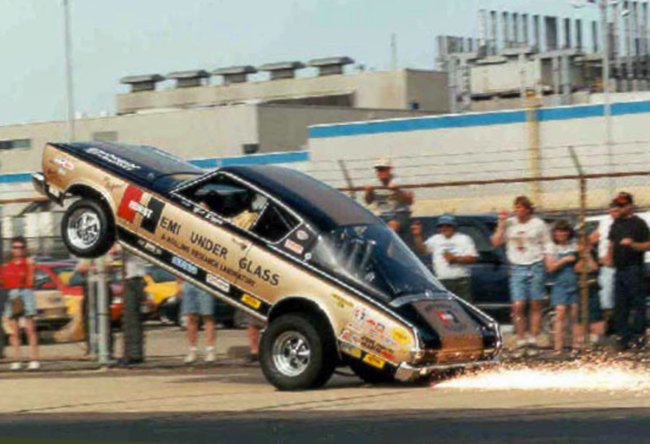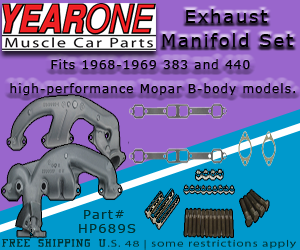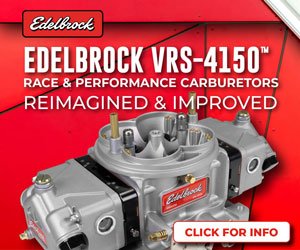
Over 55 years ago, in some long-forgotten Glenside, Pennsylvania board meeting, George Hurst and the Hurst Performance Product Company executives decided to showcase their merchandise with a 1965 Plymouth Barracuda. The plan was to slip an injected 426 Hemi under the commodious rear window in the area that once housed the back seat — as depicted in the April 1965 Hot Rod advertisement.
Because of the engine relocation, the Barracuda’s weight transfer characteristics resulted in an excessive lift of the front wheels into the air (known as a wheelie) while traversing the ¼-mile strip. The Barracuda, adorned with the Hurst Hemi Under Glass moniker as noted in the September 1965 Hot Rod ad, became the first wheel-standing exhibition vehicle.
Above left: This April 1965 Hot Rod advertisement says it all. George Hurst stated, “We’ll drop a Hemi in the rear and run like Hell.” A 1965 Barracuda was developed to showcase the Hurst products. Initially, the Barracuda was designed to run in the Factory Experimental (FX) classes, but with the placement of the engine in the rear, the front end tended to lift under acceleration. Above right: As illustrated in the September 1965 Hot Rod advertisement, the Hemi placement in the Barracuda led to the nickname the Hurst Hemi Under Glass. The Hemi Under Glass was the original wheel stander, and for the first year, Bill Shrewsberry handled the driving chores.
To handle the driving chores of the Hurst Hemi Under Glass, George Hurst tapped “Wild Bill” Shrewsberry, an experienced and gifted driver that had previously shoed rides for Mickey Thompson and Jack Chrisman. Shrewsberry was pivotal in developing techniques to drive the Barracuda.
After a single year of promoting the Barracuda and the Hurst name, he stepped out of the driver seat to pursue other projects, including working on the Hurst Hairy Oldsmobile, the Dodge “Little Red Wagon”, and piloting the L.A. Dart. The Little Red Wagon and the L.A. Dart were both wheel standers with a Hemi engine located at the rear of the vehicle.

Hurst mechanic and fabricator Bob Riggle took over the Hurst Hemi Under Glass’s driving chores in 1966. However, after George Hurst’s partner (Bill Campbell) sold his interest in the business to Sunbeam Products in 1970, the Hurst name was dropped from the subsequent Hemi Under Glass Barracudas of the 1970s. Riggle’s wheel standing career was put on hold after a terrible accident in 1975 at US 30 Dragway.
Riggle returned in 1992 with an injected 1966 Barracuda. His career permanently ended in 2016 with the famous rollover of the supercharged 426 1968 Barracuda with Jay Leno riding shotgun. Riggle drove many different Barracudas during his career, including the original ’65 Barracuda (reskinned as a ’66), a ’67 Barracuda, a second ’66 Barracuda, and the most famous of all: the ’68 Barracuda.


To continue the Hemi Under Glass name, Mike Mantel was introduced as the third driver of the celebrated franchise in 2016.
While Mantel has continued with the 1968 Barracuda, he was expected to debut a late-model Hellcat Hemi-equipped Challenger wheel stander. The debut has been limited due to the COVID-19 concerns.
After his partner sold out, George Hurst (and Hurst financier Lawrence Greenwald) continued with Sunbeam Products but with incrementally reduced input.
By the mid-1970s, both Hurst and Greenwald were forced out of the company. Both men died in 1986. George Hurst was only 59 years old.
In 1987, Sunbeam Products sold its interest in Hurst to the Mr. Gasket Company. By 2007, B&M Racing and Performance Products had acquired the Hurst brand.
Now a business under the Holley corporate umbrella, Hurst continues to innovate industry-leading performance products.
Hurst’s latest creation, the Elite Series line of performance products for modern muscle cars, includes its world-famous shifters, exhaust systems, wheels, springs, floor mats, and graphics. The Elite Series line provides the essential parts necessary to build a modern version of the ‘60s and ‘70s classic Hurst cars inspired by George Hurst.









